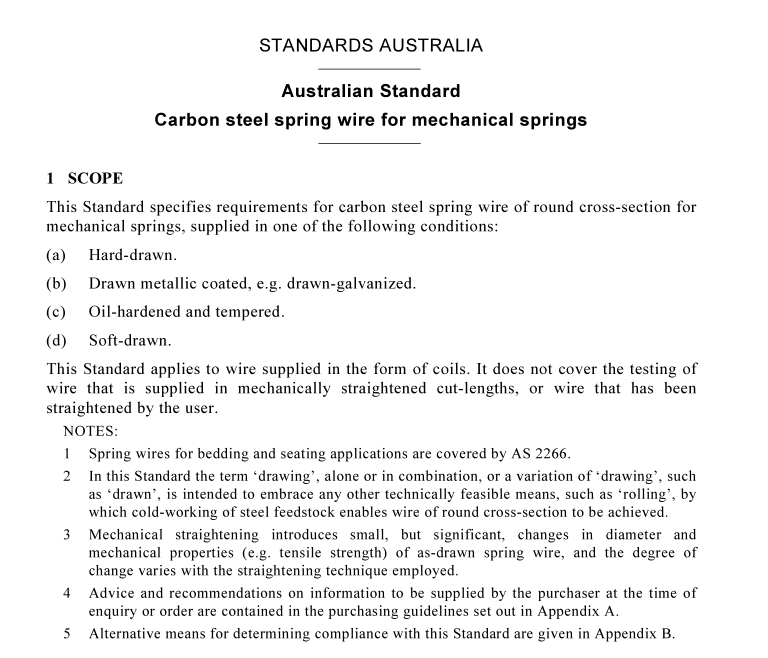AS 1472 pdf download – Carbon steel spring wire for mechanical springs

AS 1472 pdf download – Carbon steel spring wire for mechanical springs
3 DEFINITIONS For the purpose of this Standard, the definitions below apply.
3.1 Batch A quantity of wire produced under conditions that are considered to be uniform. NOTE: Each batch is assumed, as far as practicable, to consist of items of a single type or condition, grade, class, size and composition, and to have been manufactured under essentially the same conditions at essentially the same time.
3.2 Block The capstan, specifically of a wire drawing machine, on which the coil of wire in its final (wire) diameter is enabled to be progressively accumulated and formed into the desired configuration, mass and dimensions for supply to the purchaser.
3.3 Cast The form taken by the individual waps (rings, turns or circles) of a wire within a coil. NOTE: When a wap is cut from a coil of spring wire, it may freely assume one of two geometrical shapes, or casts, namely—
(a) a cast, as exhibited, in general, by block-wound hard-drawn, soft-drawn and drawn metallic coated wires, and characterized by overall diameter of the wap and helical separation of its cut ends; or
(b) nominally a straight-line (or rectilinear) cast, this latter being a notable characteristic of oil- hardened and tempered wire, but also being a feature of certain groups of hard-drawn and drawn metallic coated wires.
3.4 Cast analysis Analysis determined, for such elements as have been specified, on a test sample obtained during the pouring of the liquid steel; also known as heat analysis. 3.5 Coil A continuous length of wire, neatly and compactly wound, and containing no mechanical joints (such as knots), but may contain electric resistance butt-welds; it may be supplied unsupported, being in the general form of a torus (quoit shape), or it may be supplied supported on a transportable carrier (see Clause 4.5).
3.6 Drawn metallic coated Carbon steel wire cold-worked by drawing to final size, after metallic coating and with a minimum of 40% reduction of cross-sectional area, from a heat-treated (patented or similar process) base. NOTE: The metallic coating to be applied at an intermediate stage of wire processing may be either zinc or zinc/aluminium alloy, as defined in Clauses
3.15 and 3.16 respectively.
3.7 Electrodeposited zinc coating A coating of zinc of at least 98% purity, applied to the wire using a specialized continuous electrolytic process (see Clause 3.15 and Note to Clause 3.8). 3.8 Galvanized Describes a protective coating obtained by dipping (immersing) prepared steel wire in a bath of molten zinc of purity not less than 98%. NOTE: By definition, the terms ‘galvanized’ and, by extension, ‘galvanizing’ relate strictly to the hot-dip application of zinc. However, zinc coatings applied by alternative processes may also be referred to as ‘galvanized’, provided they are distinguished at all times by a distinctive, process- specific qualifier or prefix, such as ‘electrolytic’ or ‘electro’ (but not by cryptic abbreviations, such as ‘e-’ or ‘el’).
3.9 Hard-drawn Carbon steel wire cold-worked by drawing with a minimum of 40% reduction of cross- sectional area from a heat-treated (patented or similar process) base. 3.10 Oil-hardened and tempered Carbon steel wire heat-treated in line by first transforming into austenite, quenching in oil or other suitable medium, followed by tempering at an appropriate temperature. NOTE: Oil-hardened and tempered wire is conventionally termed ‘oil-tempered wire’ within the wire industry.
3.11 Ovality The difference between the maximum and minimum diameters of the wire, measured at the same cross-section; also known as out-of-roundness.
3.12 Patenting A wire industry term for a continuous heat treatment process for either hot-rolled rod feedstock or wire at an intermediate stage of processing, whereby the rod or wire is held at austenitizing temperature (typically 850–950°C), followed by a controlled cooling operation involving essentially isothermal transformation (at typically 500–530°C) of the steel’s microstructure to fine pearlite.
3.13 Soft-drawn Wire drawn with a reduction of cross-sectional area of approximately 10% from a spheroidize-annealed base. 3.14 Wap Individual ring, turn or circle, of wire within any coil, or an individual ring, turn or circle, cut from a block-wound coil.
3.15 Zinc coating A coating composed essentially of zinc, with or without zinc/iron-alloy formation at the zinc/iron interface, and produced in a continuous operation by dipping (immersing) prepared and separated single strands of steel wire in a bath of at least 98% purity by mass of molten zinc (see Clause 3.8), or in an electroplating bath having zinc anodes and/or containing a solution of an appropriate zinc salt (see Clause 3.7); NOTE: Small amounts of certain chemical elements or compounds may be added to the molten zinc or to the electroplating bath to impart special properties to the zinc coating.









